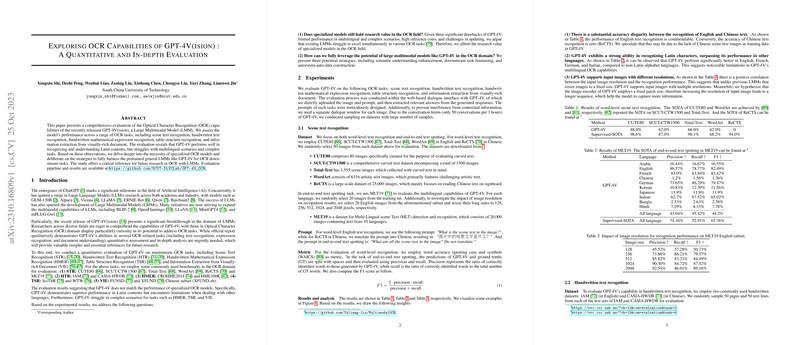An In-depth Evaluation of OCR Capabilities in GPT-4V(ision)
The paper "Exploring OCR Capabilities of GPT-4V(ision): A Quantitative and In-depth Evaluation" provides a comprehensive assessment of the OCR potential of GPT-4V, a Large Multimodal Model (LMM). This inquiry dissects GPT-4V's efficacy across several OCR tasks, including scene text recognition, handwritten text recognition, handwritten mathematical expression recognition, table structure recognition, and information extraction from visually-rich documents. The paper produces a granular analysis of GPT-4V's performance, pointing out its strengths and limitations within diverse OCR scenarios.
Key Findings
One of the notable observations made in the paper is GPT-4V's proficiency in managing Latin-based text recognition tasks, where its performance is comparable to existing OCR models. However, GPT-4V reveals significant shortcomings when tasked with recognizing non-Latin languages and executing complex OCR operations. This includes difficulties in recognizing handwritten mathematical expressions and understanding the structure of intricate tables. On more sophisticated tasks such as end-to-end semantic entity recognition and table structure recognition, GPT-4V falls short of achieving the performance of specialized OCR models.
Moreover, despite GPT-4V's strong potential derived from its multimodal capabilities, it does not surpass the state-of-the-art OCR algorithms in any of the tasks evaluated. The inference costs and update challenges associated with GPT-4V also diminish its practicality in real-world applications.
Implications and Future Directions
The paper highlights the ongoing relevance of specialized OCR models. Given the inability of LMMs like GPT-4V to conquer the multifaceted requirements of complex OCR tasks, domain-specific models remain indispensable. Nonetheless, the paper casts light on the promising potential of leveraging LMMs for augmentative purposes in OCR research.
For the future development of OCR technologies utilizing LMMs, several prospective pathways are suggested:
- Enhancing Semantic Understanding: Leveraging the enhanced semantic capabilities of LMMs can considerably improve document comprehension and related tasks.
- Downstream Task Fine-tuning: Tailoring LMMs to specific OCR scenarios through task-specific fine-tuning can capitalize on pre-trained models' extensive knowledge bases within constrained data environments.
- Automated Data Construction: LMMs can be utilized for automatic or semi-automatic data annotation and generation, effectively reducing the manual labor typically incumbent upon data preparation and labeling processes.
Conclusion
In conclusion, this paper offers a critical evaluation of GPT-4V's OCR capabilities, revealing both its potential and limitations. While it demonstrates solid competency in Latin-based recognition tasks, significant deficiencies are evident in its handling of multilingual and particularly complex OCR tasks. The paper posits a well-thought-out framework for future research, highlighting how the intrinsic strengths of LMMs could be harnessed to complement and enhance traditional OCR approaches. As general multimodal models continue to evolve, their ability to assimilate and specialize in OCR tasks will likely become central to their integration into advanced AI applications.
